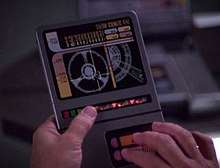LCARS
In the Star Trek fictional universe, LCARS (/ˈɛlkɑːrz/; an acronym for Library Computer Access/Retrieval System) is a computer operating system. Within Star Trek chronology, the term was first used in the Star Trek: The Next Generation series.
| LCARS | |
|---|---|
 LCARS-style desktop | |
| Plot element from the Star Trek franchise | |
| First appearance | Star Trek: The Next Generation |
| Created by | Michael Okuda[1] |
| Genre | Science fiction |
| In-story information | |
| Type | Computer operating system |
Production
The LCARS graphical user interface was designed by scenic art supervisor and technical consultant Michael Okuda. The original design concept was influenced by a request from Gene Roddenberry that the instrument panels not have a great deal of activity on them.[2] This minimalized look was designed to give a sense that the technology was much more advanced than in the original Star Trek.[2] The early display panels were made out of colored plexiglas with light behind them, a technique that can produce complex-looking displays cheaply. At times, pieces of green material were used on control panels so that complex animations could be added in post-production via the chroma key process.
As the show progressed, use of animations increased. Most were displayed on video equipment built into the sets. Depending on the camera angle, the animated LCARS graphic might appear curved due to the use of cathode-ray tube (CRT) screens. As flat-panel display technology became available, set design moved away from the CRT displays, giving the animated LCARS graphics a closer appearance to the static graphics.
On Star Trek: The Next Generation, many of the buttons were labeled with the initials of members of the production crew and were referred to as "Okudagrams."[1]
When Michael Okuda was asked about the design of the LCARS display, he responded "I came up with the LCARS style in part because of Gene Roddenberry's directive that he wanted his new Enterprise to be so advanced that it looked simple and clean. The other part of the LCARS style was that it had to be something that could be manufactured quickly and easily on a television budget."
PADD

In the Star Trek franchise, the LCARS interface is often seen used on a PADD (Personal Access Display Device), a hand-held computer.[3]
PADDs of various designs and interfaces are used throughout the Star Trek universe by such species as Humans, Klingons, Romulans, Vulcans, Andorians, Bajorans, and Cardassians. They are common to cultures even as distant as the Delta Quadrant.
Contemporary comparisons
At 7 inches (18 cm), similarly sized modern tablets such as the Nexus 7, Amazon Fire, BlackBerry PlayBook, and iPad Mini have been compared with the PADD.[4][5] Several mobile apps are available which offer an LCARS-style interface.[6][7]
Legal
CBS Television Studios claims to hold the copyright on LCARS. Google was sent a DMCA letter to remove the Android app called Tricorder since its use of the LCARS interface was un-licensed. The application was later re-uploaded under a different title, but it was removed again.[8]
References
- Sternbach, Rick; Okuda, Michael (1991). Star Trek: The Next Generation Technical Manual. Pocket Books. ISBN 0-671-70427-3.
- "Michael Okuda interview". Star Trek: The Magazine. Vol. 1 no. 7. November 1999. p. 22.
- Stuart, Rick D.; Terra, John (September 1988). Star Trek: The Next Generation Officer's Manual. FASA Corporation. ISBN 1-55560-079-4.
- Fung, Brian (26 July 2012). "Make It So: What Star Trek Tells Us About How to Make Tablets". The Atlantic.
- Foresman, Chris (September 10, 2016). "How Star Trek artists imagined the iPad… nearly 30 years ago". Ars Technica.
- Pascale, Anthony (April 11, 2010). "New 'LCARS' iPad Application Released". TrekMovie.com.
- Paul, Ryan (July 16, 2011). "Make It So: Hands-On With Official Star Trek iPad App". Wired.
- "Tricorder - Android Projects by Moonblink". Google Project Hosting. Archived from the original on October 27, 2012.
External links
| Wikimedia Commons has media related to LCARS. |
- LCARS at Memory Alpha (a Star Trek wiki)
- PADD at Memory Alpha (a Star Trek wiki)
